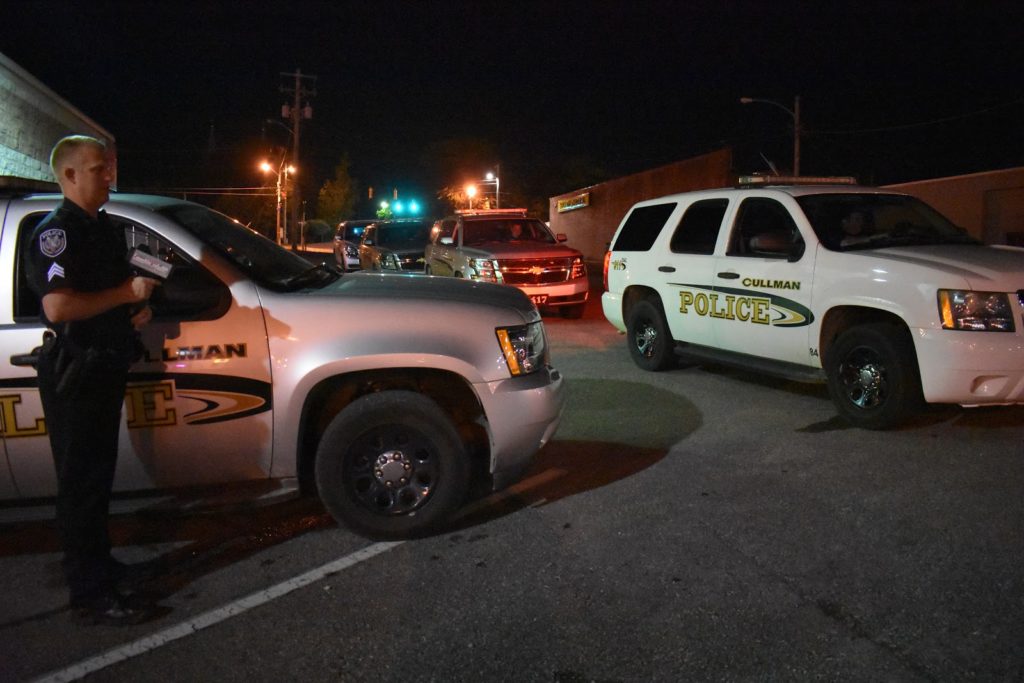
CULLMAN, Ala. – During a press conference last Thursday (www.cullmantribune.com/2019/08/30/local-law-enforcement-alea-come-together-to-promote-road-safety-in-cullman-county/), local law enforcement officials talked about the high number of vehicle crashes across Cullman County. Mention was made of “saturation patrolling,” the deployment of higher numbers of resources than usual to particularly dangerous areas that have seen high numbers of wrecks, and Friday evening the Cullman Police Department (CPD) took The Tribune along on such an operation.
Termed a “selective traffic enforcement detail,” CPD Traffic Homicide Investigator Sgt. Joey Duncan and four patrol officers set up along U.S. Highway 31 in downtown Cullman, an area that has seen numerous wrecks this year. Duncan used a LIDAR (Light Detection and Ranging) unit, a device like a radar gun that uses a highly accurate laser beam and optics that can target and determine the speed of a specific vehicle, to register speeders. Once the speed of a car or truck was found to be at or beyond a certain level above the posted speed limit, a patrol officer went to work, stopping the offending vehicle and issuing a written warning or ticket depending on the speed recorded and other factors that might be found during the stop or license/insurance check.
Said Duncan, “On set days, we’ll get several officers out here, and I’m an instructor in the LiDAR, so I’ll observe the speed through the device, and then officers will stop them based upon that speed. Basically, what we’re doing is saturating an area where we’ve worked a lot of crashes over the last two weeks, and then we’re doing selective enforcement for the violations that are contributing or causing the crash, which is speed, distraction and following too close.
“This is a new technique, along with public awareness, that we’ve been doing, because it’s showing positive results to the goal we’re trying to accomplish: reducing crashes, especially serious injury-type and fatalities.
“What we look at is, when we print off our stats, where we had the most crashes within the two weeks or the month we’re working, and that’s where we’re going after, those areas.”
Asked about areas where details have previously carried out operations, Duncan said the CPD has seen positive results.
Duncan showed The Tribune 2019 crash numbers, after the institution of saturation patrolling details, along a road that was particularly bad in 2018, and the number of incidents was significantly lower.
Said Duncan, “The message is getting out, you know, which is what we want. We want people to slow down, pay attention, not be distracted and don’t cause a crash.”
During Friday evening’s operation, which lasted an hour and a half, the detail cited 50 traffic violations in a two-block stretch of Highway 31.
As the operation went on, the number of speeders seemed to drop off, aided, no doubt, by the occasional sight of flashing blue lights down the street. Duncan speculated that social media might play a role, as well, with drivers warning other drivers about what was happening. That was fine with him, as he noted that the real point of the program is not to see how many drivers they can stop.
According to the sergeant, “Our goal’s not to write everybody a ticket; it’s to change the behavior of the driver.”
Statistics show crashes on the rise statewide for several years
A review of state crash statistics since 2008 shows that the number of vehicle crashes has been steadily rising across the state over that period. The number of injuries has also been on the rise, though the number of fatalities has begun to taper off recently. The numbers of licensed drivers and registered vehicles have also been growing, but not as fast as accidents and injuries. The vehicular fatality rate in Alabama is consistently slightly higher than the national rate.
Crash facts
- Friday is the most common day for wrecks.
- Sunday is the most common day for fatalities.
- The largest number of crashes occurs between noon and 6 p.m., with 3-6 p.m. being the most dangerous period.
- The most common age range for drivers who cause wrecks is 15-24 years old, for males and females.
- The most common age range for fatalities is 21-30 years old.
- More wrecks occur in urban areas, but more fatalities occur in rural areas.
- Shopping/business/retail districts are the most dangerous areas, accounting for almost 60% of crash locations.
Cullman County and City
In 2017, the most recent year for which full statistics are available, these are the crash numbers for Cullman and surrounding counties:
- Cullman – 2,478
- Walker – 1,661
- Winston – 306
- Lawrence – 519
- Morgan – 3,136
- Marshall – 2,580
- Blount – 917
City of Cullman v. other Alabama cities
Against cities roughly the same size (population within 1,000 plus or minus) as Cullman (based on 2010 census numbers and 2017 crash statistics):
- Cullman (15,858 population) – 992
- Center Point – 21
- Millbrook – 459
- Hueytown – 166
- Talladega – 290
Note that 2017 had the lowest number of wrecks in recent years for Cullman. In both 2016 and 2018 the city saw slightly more than 1,000 crashes.
Copyright 2019 Humble Roots, LLC. All Rights Reserved.

Saturation patrol: as Cullman Police Sgt. Joey Duncan registers vehicle speeds in a specified high-crash area, multiple CPD officers prepare to go after speeders and drivers committing other violations. (W.C. Mann for The Cullman Tribune)































